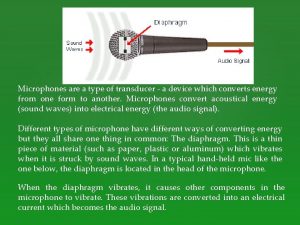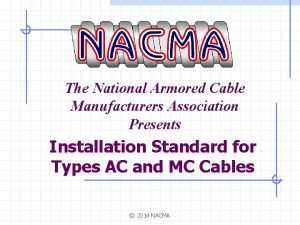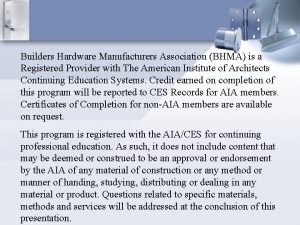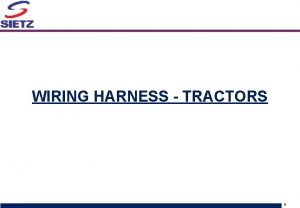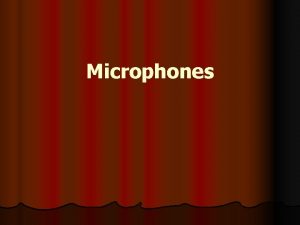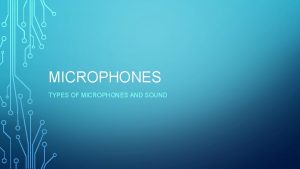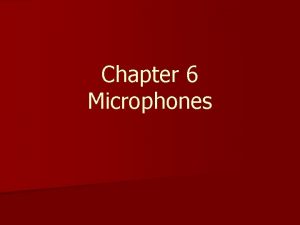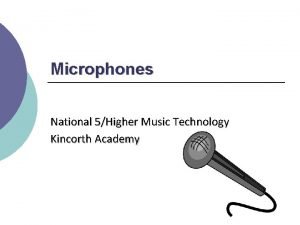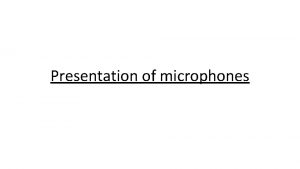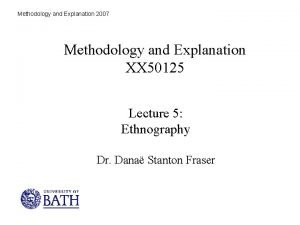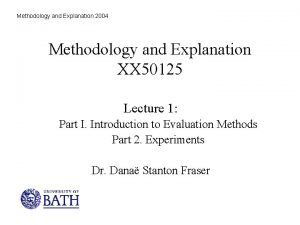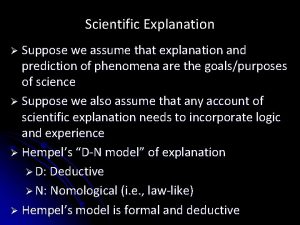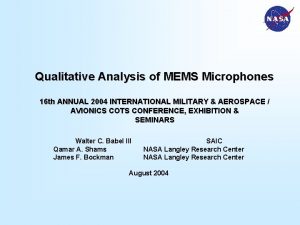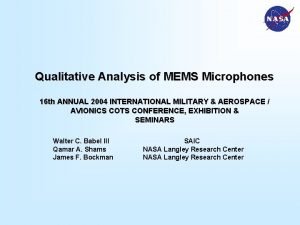MICROPHONES Explanation Illustration and Analysis Manufacturers Specification How

























- Slides: 25

MICROPHONES • • • * Explanation, Illustration and Analysis *Manufacturers Specification *How Performance Is Measured

Aims �How Performance is measured: v. Polar Patterns (Direction) v. Range (sensitivity) v. Type, Purpose, Best Use v. Frequency Response v. Power

Aims �Manufacturer’s Spec (Embeded) v. Shure SM 58 v. Behringer B 2 Pro v. AKG D 112 v. Type 40 DP High Pressure Mic

Directional properties on microphones are important so that you can choose the right microphone for the right job. A Microphone with a 360° ‘Polar’ pattern would be no good for recording a mono source, and one with a Uni-Directional / Cardiod ‘Polar’ pattern would be no good for recording a Brass Band.

TYPICAL POLAR PATTERNS www. soundonsound. com

Range Whether a Mic is designed for close or long range ‘pick up’ is also important so that you can choose the right microphone for the right job. A Microphone with a long range would be no good for live vocals, and one with a short range would be no good for recording an Orchestra.

SHURE SM 58 Dynamic Microphone Close Range

BEHRINGER B 2 PRO – ‘Studio Condenser’ Long Range

Frequency Response refers to which sounds or tones a mic is able to pick up. Some mics are designed for very low frequencies, some for very high, and some for a broad range of frequencies

SHURE SM 58 – Dynamic Mic www. shure. co. uk

BEHRINGER B 2 PRO – ‘Studio Condenser www. amazon. com

AKG D 112 – Dynamic Mic �Although this Mic is designed to pick up a fairly wide range of frequencies it specialises in the lower end of the ‘Audio Spectrum. ’ www. studiospares. com

Type 40 DP HIGH PRESSURE MIC �This little Mic is specifically designed to pick up very high frequencies, in fact, much higher than a human ear can!

Type 40 DP HIGH PRESSURE MIC www. gras. dk

Frequency Response Of course there are lots of mics that cover wide ‘Frequency Ranges’ but users develop preferences for certain mics for their ‘sound. ’ Each design is different and the resulting specialities in Frequency Response can make distinctive differences when choosing which mic to use.

MICROPHONE TYPE �There are many types of microphone, using different technologies to ‘pick up’ and conduct an audio signal. �We use two of the most common types: � 1) Dynamic � 2) Condensor

DYNAMIC MICROPHONES �Work by means of Sound Waves vibrating a ‘Diaphragm. ’ �The moving diaphragm then moves a ‘Coil, ’ forwards and backwards across a Magnet. �The combination of coil, magnet and motion creates a tiny current that is sent to be amplified.

DYNAMIC MICROPHONES www. mediacollege. com

DYNAMIC MICROPHONES �Generally more rugged �Better at handling high loads �Less sensitive �Have no batteries �Require no external power �Are generally tailored to suit a specific ‘Frequency Range’ for specific applications

DYNAMIC MICROPHONES �Examples: SHURE SM 58 AKG D 440

CONDENSER MICROPHONES �The word Condenser is the ‘old’ word for ‘Capacitor. ’ A Capacitor is an electrical component that stores electrostatic energy �A Condenser Mic uses a Capacitor to convert acoustic vibration into electrical energy �Works by placing a diaphragm between two electrical plates that pass current between them

CONDENSER MICROPHONES www. mediacollege. com

CONDENSER MICROPHONES �As the diaphragm vibrates the distance between the two plates changes creating the variants in signal �A Voltage (commonly 48 v) is required to power the capacitor �This could be from a battery or ‘Phantom Power. ’

CONDENSER MICROPHONES �Have wider, flatter frequency responses than Dynamic Microphones and deliver stronger signals. �Are more sensitive and better for long range applications �Better for picking up ‘Nuances’ (Variations) in music �Not as good for high volumes as they tend to distort easily

CONDENSER MICROPHONES �Examples: AKG C 1000 s Behringer B 2 Pro
 Is microphone a transducer
Is microphone a transducer Pie paragraphs
Pie paragraphs Pie structure
Pie structure Upper specification limit and lower specification limit
Upper specification limit and lower specification limit Natural variations operations management
Natural variations operations management Software requirement analysis and specification
Software requirement analysis and specification Mc cable uses not permitted
Mc cable uses not permitted Raw template
Raw template Difference between job description and job specification
Difference between job description and job specification Job analysis for personal specification
Job analysis for personal specification Petechiae
Petechiae Mil subj
Mil subj Normal tax
Normal tax Water pollution and unequal distribution illustration
Water pollution and unequal distribution illustration Very descriptive
Very descriptive Formative assessment analyze and explain this illustration
Formative assessment analyze and explain this illustration Shitao landscape
Shitao landscape Illustration of the steps in restriction digestion and pcr
Illustration of the steps in restriction digestion and pcr Hull identification number
Hull identification number Best autogyro
Best autogyro European diagnostic manufacturers association
European diagnostic manufacturers association Builders hardware manufacturers association
Builders hardware manufacturers association Sai paradise machine tools
Sai paradise machine tools Manufacturers seeking distributors
Manufacturers seeking distributors Vesuvius refractory products
Vesuvius refractory products Pmmai
Pmmai
